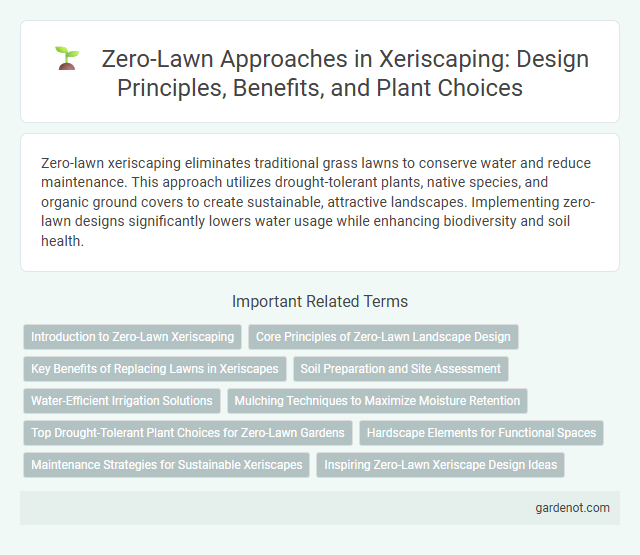Zero-lawn xeriscaping eliminates traditional grass lawns to conserve water and reduce maintenance. This approach utilizes drought-tolerant plants, native species, and organic ground covers to create sustainable, attractive landscapes. Implementing zero-lawn designs significantly lowers water usage while enhancing biodiversity and soil health.
Introduction to Zero-Lawn Xeriscaping
Zero-lawn xeriscaping eliminates traditional grass lawns by replacing them with drought-tolerant plants, reducing water consumption significantly. Native shrubs, succulents, and mulch are strategically used to create sustainable landscapes with minimal irrigation needs. Adopting zero-lawn xeriscaping supports water conservation, lowers maintenance costs, and promotes environmental resilience.
Core Principles of Zero-Lawn Landscape Design
Zero-lawn landscape design prioritizes water conservation by eliminating traditional grass lawns, replacing them with drought-tolerant plants, native species, and permeable surfaces that reduce water runoff. This approach emphasizes soil health, efficient irrigation methods such as drip systems, and mulching to retain moisture and improve soil structure. By integrating biodiversity and minimizing waste, zero-lawn designs create sustainable, low-maintenance outdoor spaces aligned with xeriscape principles.
Key Benefits of Replacing Lawns in Xeriscapes
Zero-lawn xeriscapes significantly reduce water consumption by eliminating traditional grass that requires frequent irrigation, making them ideal for drought-prone regions. They enhance biodiversity and soil health by incorporating native, drought-tolerant plants that support local ecosystems. Maintenance costs and efforts decrease substantially since zero-lawn designs require less mowing, fertilizing, and pest control compared to conventional lawns.
Soil Preparation and Site Assessment
Effective xeriscape design begins with thorough site assessment, including soil type analysis and drainage patterns to identify water retention capabilities. Soil preparation involves amending native soil with organic matter and mulch to enhance moisture conservation and nutrient availability. Careful grading reduces runoff and promotes deep root growth, optimizing plant health in zero-lawn landscapes.
Water-Efficient Irrigation Solutions
Zero-lawn xeriscape designs prioritize water-efficient irrigation solutions such as drip systems and smart controllers that precisely deliver moisture to plant roots, minimizing water waste. Employing recycled water and rain sensors further enhances irrigation efficiency in zero-lawn landscapes, reducing overall water consumption. These methods support sustainable garden maintenance by optimizing water use and promoting drought-resistant plant species.
Mulching Techniques to Maximize Moisture Retention
Mulching techniques in zero-lawn xeriscape landscapes significantly enhance moisture retention by creating a protective barrier that reduces evaporation and moderates soil temperature. Organic mulches such as bark, compost, and straw enrich the soil while conserving water, promoting healthier plant growth in arid environments. Applying a 2-4 inch layer of mulch around drought-resistant plants effectively reduces water usage by up to 50%, supporting sustainable landscaping practices.
Top Drought-Tolerant Plant Choices for Zero-Lawn Gardens
Top drought-tolerant plant choices for zero-lawn gardens include native succulents such as agave and aloe, which thrive with minimal water and require low maintenance. Ornamental grasses like blue fescue and buffalo grass offer resilience and texture while conserving water. Incorporating deep-rooted perennials such as yarrow and lavender also enhances soil stability and supports extended drought conditions.
Hardscape Elements for Functional Spaces
Hardscape elements such as permeable pavers, gravel paths, and natural stone patios create zero-lawn xeriscape designs that conserve water while enhancing functionality. Incorporating retaining walls and raised beds defines outdoor living areas and supports efficient irrigation systems. These durable materials reduce maintenance needs and provide versatile spaces for dining, relaxation, and gardening without compromising sustainability.
Maintenance Strategies for Sustainable Xeriscapes
Zero-lawn xeriscapes prioritize native drought-tolerant plants and efficient irrigation techniques to minimize water use and maintenance requirements. Mulching and soil improvement enhance moisture retention and reduce weed growth, while drip irrigation systems deliver water directly to plant roots, optimizing water use efficiency. Regular monitoring and adaptive pruning are essential to sustain plant health and ensure landscape resilience in arid environments.
Inspiring Zero-Lawn Xeriscape Design Ideas
Transform outdoor spaces with zero-lawn xeriscape designs that emphasize drought-tolerant plants such as succulents, native grasses, and ornamental shrubs, reducing water consumption significantly. Incorporating permeable materials like decomposed granite and mulch pathways prevents soil erosion while maintaining a natural aesthetic. Wildlife-friendly features, including birdbaths and pollinator gardens, enhance biodiversity and create sustainable, visually appealing landscapes.
Zero-lawn Infographic

 gardenot.com
gardenot.com